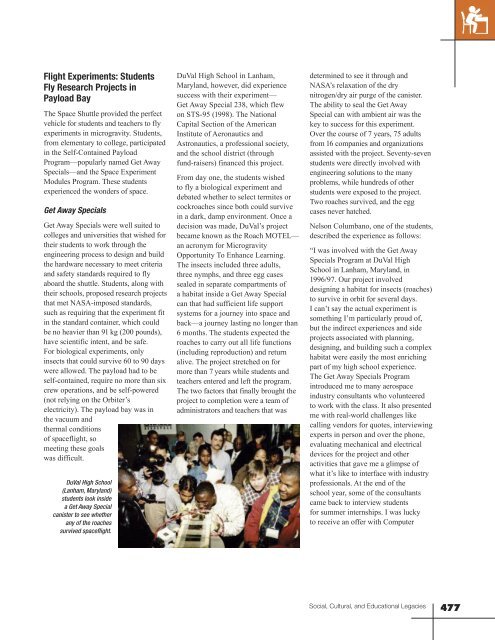Social, Cultural and Educational Legacies - ER - NASA
Social, Cultural and Educational Legacies - ER - NASA
Social, Cultural and Educational Legacies - ER - NASA
You also want an ePaper? Increase the reach of your titles
YUMPU automatically turns print PDFs into web optimized ePapers that Google loves.
Flight Experiments: StudentsFly Research Projects inPayload BayThe Space Shuttle provided the perfectvehicle for students <strong>and</strong> teachers to flyexperiments in microgravity. Students,from elementary to college, participatedin the Self-Contained PayloadProgram—popularly named Get AwaySpecials—<strong>and</strong> the Space ExperimentModules Program. These studentsexperienced the wonders of space.Get Away SpecialsGet Away Specials were well suited tocolleges <strong>and</strong> universities that wished fortheir students to work through theengineering process to design <strong>and</strong> buildthe hardware necessary to meet criteria<strong>and</strong> safety st<strong>and</strong>ards required to flyaboard the shuttle. Students, along withtheir schools, proposed research projectsthat met <strong>NASA</strong>-imposed st<strong>and</strong>ards,such as requiring that the experiment fitin the st<strong>and</strong>ard container, which couldbe no heavier than 91 kg (200 pounds),have scientific intent, <strong>and</strong> be safe.For biological experiments, onlyinsects that could survive 60 to 90 dayswere allowed. The payload had to beself-contained, require no more than sixcrew operations, <strong>and</strong> be self-powered(not relying on the Orbiter’selectricity). The payload bay was inthe vacuum <strong>and</strong>thermal conditionsof spaceflight, someeting these goalswas difficult.DuVal High School(Lanham, Maryl<strong>and</strong>)students look insidea Get Away Specialcanister to see whetherany of the roachessurvived spaceflight.DuVal High School in Lanham,Maryl<strong>and</strong>, however, did experiencesuccess with their experiment—Get Away Special 238, which flewon STS-95 (1998). The NationalCapital Section of the AmericanInstitute of Aeronautics <strong>and</strong>Astronautics, a professional society,<strong>and</strong> the school district (throughfund-raisers) financed this project.From day one, the students wishedto fly a biological experiment <strong>and</strong>debated whether to select termites orcockroaches since both could survivein a dark, damp environment. Once adecision was made, DuVal’s projectbecame known as the Roach MOTEL—an acronym for MicrogravityOpportunity To Enhance Learning.The insects included three adults,three nymphs, <strong>and</strong> three egg casessealed in separate compartments ofa habitat inside a Get Away Specialcan that had sufficient life supportsystems for a journey into space <strong>and</strong>back—a journey lasting no longer than6 months. The students expected theroaches to carry out all life functions(including reproduction) <strong>and</strong> returnalive. The project stretched on formore than 7 years while students <strong>and</strong>teachers entered <strong>and</strong> left the program.The two factors that finally brought theproject to completion were a team ofadministrators <strong>and</strong> teachers that wasdetermined to see it through <strong>and</strong><strong>NASA</strong>’s relaxation of the drynitrogen/dry air purge of the canister.The ability to seal the Get AwaySpecial can with ambient air was thekey to success for this experiment.Over the course of 7 years, 75 adultsfrom 16 companies <strong>and</strong> organizationsassisted with the project. Seventy-sevenstudents were directly involved withengineering solutions to the manyproblems, while hundreds of otherstudents were exposed to the project.Two roaches survived, <strong>and</strong> the eggcases never hatched.Nelson Columbano, one of the students,described the experience as follows:“I was involved with the Get AwaySpecials Program at DuVal HighSchool in Lanham, Maryl<strong>and</strong>, in1996/97. Our project involveddesigning a habitat for insects (roaches)to survive in orbit for several days.I can’t say the actual experiment issomething I’m particularly proud of,but the indirect experiences <strong>and</strong> sideprojects associated with planning,designing, <strong>and</strong> building such a complexhabitat were easily the most enrichingpart of my high school experience.The Get Away Specials Programintroduced me to many aerospaceindustry consultants who volunteeredto work with the class. It also presentedme with real-world challenges likecalling vendors for quotes, interviewingexperts in person <strong>and</strong> over the phone,evaluating mechanical <strong>and</strong> electricaldevices for the project <strong>and</strong> otheractivities that gave me a glimpse ofwhat it’s like to interface with industryprofessionals. At the end of theschool year, some of the consultantscame back to interview studentsfor summer internships. I was luckyto receive an offer with Computer<strong>Social</strong>, <strong>Cultural</strong>, <strong>and</strong> <strong>Educational</strong> <strong>Legacies</strong>477
















